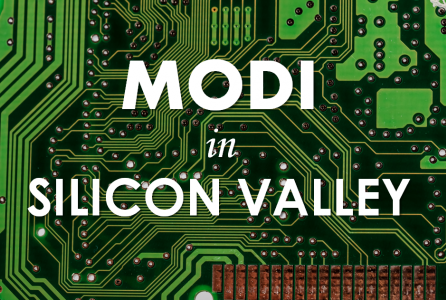
Prime Minister Narendra Modi is in the United States from 23-29 September, his second visit there in the past year. The highlight this time will be a stop at Silicon Valley – the first Indian Prime Minister to do so in more than 30 years.
Gateway House brings you a comprehensive view of the visit: the schedule, the agenda, India-U.S. tech and treaty relations, and highlights a case study on what’s really right and bright in the bilateral.
Narendra Modi’s U.S. schedule
24th – 25th September | New York City:
- Address at the UN Sustainable Development Summit.
- Hosting the G4 nations – India, Brazil, Germany, Japan – to discuss UN Security Council reforms and declare support of each others’ candidacy for permanent membership of the UNSC.
- Hosting working dinner for 50 top US CEOs including Ford Motors, Lockheed Martin, IBM, PepsiCo, Dupont, Merck, Qualcomm Inc, Abbott Laboratories.
26th September | Mountain View/Palo Alto/Stanford California:
- Visit to Google, Tesla Motors headquarters.
- Round table discussion at Stanford University on sustainable/renewable energy.
- At India-U.S. startup Konnect, organised by NASSCOM, TiE Silicon Valley and IIM Ahmedabad’s business incubator CIIE; Indian start-ups will present their products.
27th September | Menlo Park/San Jose:
- Townhall-meeting with Mark Zuckerberg at Facebook headquarters, Menlo Park.
- Address Indian diaspora at SAP Center, San Jose.
28th September | New York City:
- Bilateral with U.S. President Barack Obama on energy partnership and trade.
- Meeting with UN Secretary General Ban Ki-moon on UN Security Council reforms.
- Address at summit on peacekeeping hosted by President Obama, on India’s extensive history in global peacekeeping operations.
India-U.S. Relations
Modi’s American journey by Seema Sirohi
Even though the U.S. has made a long-term bet on India, its impatience with the Modi government continues to grow. Although the prime minister could signal India’s leads on issues internet governance, climate change and trade, U.S. might not come out impressed by the speed of Modi’s India.
Space R&D: A strategic frontier by Chaitanya Giri
Instead of inviting foreign corporations to India to create a manufacturing base, Modi can use his Silicon Valley experience to build a similar research and development foundation in India for indigenous high-tech companies. A strategic space megaproject could be the start of this much-needed push.
Byte but no BIT by Rajrishi Singhal
Behind the hullabaloo and grand optics that will accompany PM Narendra Modi’s visit to the U.S. will be laser-focused discussions on enhancing the strategic trade and investment relationship.
Innovation bridge: Silicon Valley to India by Shubhashish
Sharad Sharma, co-founder, iSpirt, talks about Prime Minister Modi’s visit to the Silicon Valley on September 27. In an in interview to Gateway House, he outlines the steps that would make Modi’s visit a success for Digital India campaign and other key issues.
Will Modi actualise the India-U.S. dream? by Nishith Acharya
On his second trip to the U.S. next week, Modi will meet Obama to discuss various issues, including climate change and the civil nuclear deal; he will also visit Silicon Valley to explore innovation and social enterprise. But beyond the promises of this agenda, both sides must now devise deliverables that make the bilateral dream a reality.
From GST to TPP by Anoop Singh
External integration—which the Trans Pacific Partnership and the Regional Comprehensive Economic Partnership will generate—has policy implications that India must manage well and quickly. As a first step, India can introduce the GST, among other measures, in order to become a more unified domestic economy.
Patel vs. Patel by Seema Sirohi
Has Hardik Patel done more harm than good to the Patel community? The Patels of the US say that their credibility has been tarnished by the protests in Gujarat. Seema Sirohi talks to Patels in America and assesses their mood.
India’s lurking TTIP challenge By Ji Xianbai
If the Transatlantic Trade and Investment Partnership moves ahead after further negotiations were held in July, Indian exporters could be disadvantaged. Instead, India must be ready to use the further opening up of huge markets across the Atlantic, and adopt trade policies that mix regionalism and multilateralism.
An agenda for Modi in Silicon Valley by Neelam Deo
Prime Minister Narendra Modi’s outreach to the influential Indian diaspora in Silicon Valley in September should be centered on creating an Indian ecosystem for tech start-ups.
India-U.S. $1 trillion: The Mahindra GenZe case study by Nishith Acharya
In the book, Nish Acharya uses case study of Mahindra Genze. He explains how the two-wheeler is being developed and run as a Silicon Valley startup. Instead of following their model of designing and building products in India before selling in the U.S., the company decided to tap into two expertise-based ecosystems in the U.S.—Silicon Valley and Detroit.
India-U.S.: Surge to $1 trillion by Dev Lewis and Nishith Acharya
Dev Lewis speaks to Nish Acharya, Visiting Fellow, U.S.-India Studies, Gateway House, on how the U.S.-India partnership can reach $1 trillion by 2030.
India-U.S. BIT: not a done deal yet by Rajrishi Singhal
India is revising the model draft agreement of its existing bilateral investment treaties. Some of the new clauses are unlikely to be accepted by either U.S. negotiators or U.S. corporations without substantial dilution.
India-U.S.: Key Stats by Gateway House
The U.S. and India share a long-standing relationship. These facts and figures highlights the complexities as well as the potential of the relationship
© Copyright 2015 Gateway House: Indian Council on Global Relations. All rights reserved. Any unauthorized copying or reproduction is strictly prohibited.

